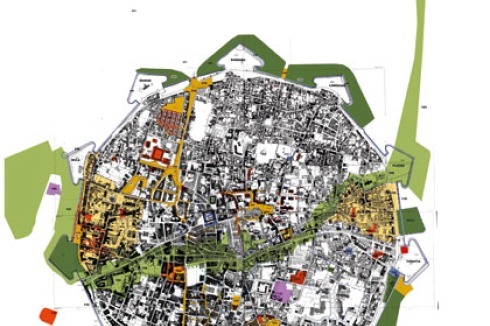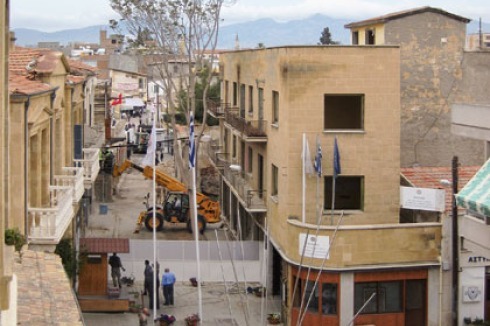Collective Masterplan
Text: Stratis, Socrates, Nikosia
-

Zeichnung: Nicosia Municipality
Zeichnung: Nicosia Municipality
-

Socrates Stratis explains why the Walled City master plan in Nicosia has become a model for bringing together the Greek and the Turkish parts of Cyprus. And he reports in which way the planning idea, which had been awarded prizes, has evolved during the last years.
I visited for the first time the north part of the walled city of Nicosia in 2003, non accessible since 1963 after the inter-communal conflict between Greek Cypriots and Turkish Cypriots. During 2003, with Cyprus in the process of joining the European Union, the Turkish army was sort of forced by Turkish Cypriots’ public demonstrations, to allow crossing of citizens between the north and south part of the island, the first time since the Turkish invasion in 1974.
One thing I will not forget was the impression I had looking at the paving of the north part of the main commercial pedestrian road of the walled-in city. It was exactly of the same design and material as its southern counterpart: concrete blocks of grey color with slim yellow colored intervals. It was indeed, thanks to this detail that I could hold on, in order to face the paradox of two parts of a city being at the same time so close and so far away from each other. It was the presence of this banal paving that had given me some hope for a possible common future of this tormented city.
Behind the paving design lies a group of people, that of Nicosia Master Plan. Greek Cypriots and Turkish Cypriots architects, planners, sociologists have been working together under the auspices of United Nations since 1979. Their aim is to build bridges, to establish areas of co-operation between the two communities. Nicosia Master Plan has an office in each part of the divided city dealing with the revitalization, the historic conservation and the future development of Nicosia across the divide. Nicosia Master Plan was recently awarded with the Agha Kahn award.
The team’s recent operations continue a twin project logic, implementing projects on both sides of the divide of the same importance: restoration of monuments and rehabilitation of neighborhoods within the walled city of Nicosia, survey of the buffer zone and management of the common sewerage infrastructure. Apart from the great effort for such work across the divide, the disadvantage of the twin project logic is that the collaboration and trust built over the years between the Turkish Cypriots and Greek Cypriots members of the team is not fully capitalized. Each team works for its twin project, juxtaposing rather than merging their efforts. Plus, the projects become more and more façade like, not dealing directly with the serious issues of the city, due to the increasing immigrant populations and degrading living environments.
Going back to the initial aim of Nicosia Master Plan, that of building bridges across, it would be important to rethink its future as an incubator for collaborations within a possible new Cypriot Federal State. How to initialize public engagement in urban practice in a post conflict area beyond the Nicosia Master Plan team? Efforts are beginning to take place, such as the international contemporary art event, Leaps of Faith, Nicosia, 2005, the Kontea project (Kontea Heritage Foundation), where Greek Cypriots and Turkish Cypriots inhabitants of the village came together to restore the mosque and the church within a general framework of cultural heritage preservation. The event based initiative (AA & U for Architecture, Art and Urbanism), which took place during the preparation of Pyla Master Plan, a community within the buffer zone, the only community where Greek Cypriots and Turkish Cypriots live together but not really sharing the public space. One should not forget the activities of the Reconstruction and Resettlement Council which is meant to prepare the island reunification process regarding the built environment. All these take place in a sensitive political context which cancels out rather often such efforts, recalling the cancellation of Manifesta 6, supposed to take place in Nicosia in 2006.
Is it possible to use such urban practice for a project of coexistence in a becoming Europe where there is more and more fear of the other and absence of persuasive actions of such kind across national limits?
x
Bauwelt Newsletter
Immer freitags erscheint der Bauwelt-Newsletter mit dem Wichtigsten der Woche: Lesen Sie, worum es in der neuen Ausgabe geht. Außerdem:
- » aktuelle Stellenangebote
- » exklusive Online-Beiträge, Interviews und Bildstrecken
- » Wettbewerbsauslobungen
- » Termine
- » Der Newsletter ist selbstverständlich kostenlos und jederzeit wieder kündbar.
Beispiele, Hinweise: Datenschutz, Analyse, Widerruf
0 Kommentare